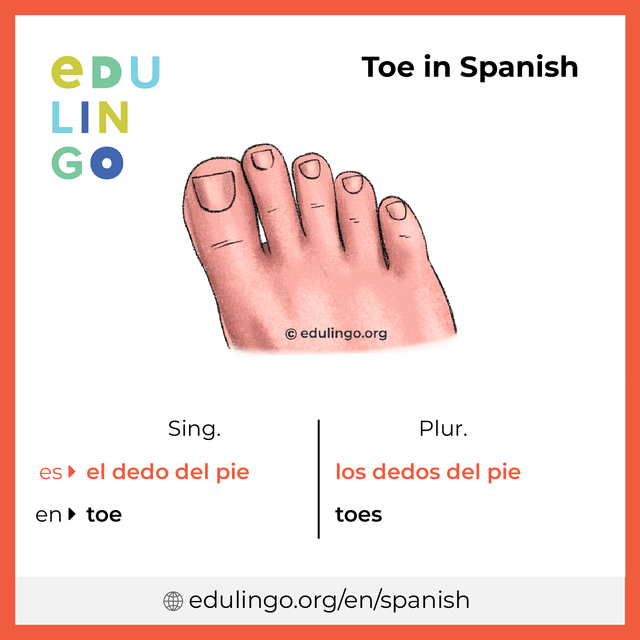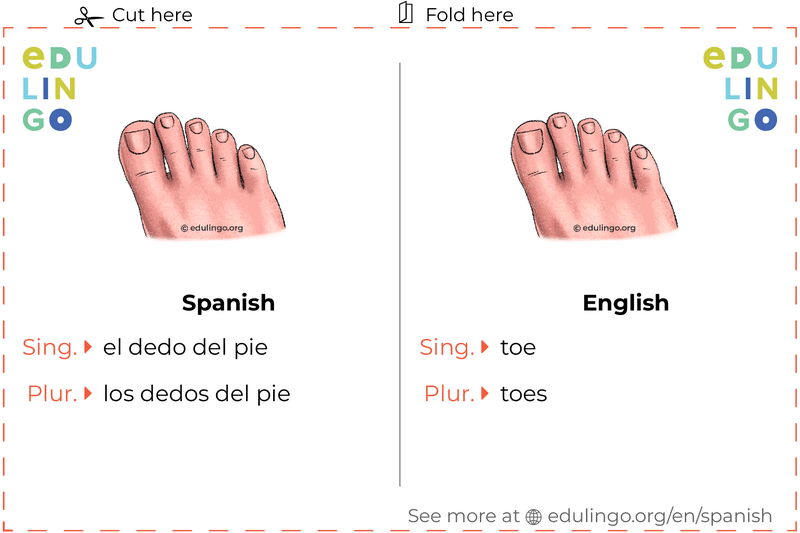Learn "Foot" In Spanish: Translations, Pronunciation & More
Ever found yourself stumbling over a simple word, wishing you could effortlessly navigate a foreign language? Understanding how to say "foot" in Spanish opens up a world of communication, from everyday conversations to nuanced expressions.
The beauty of language lies in its ability to adapt to context, and "foot" is a prime example. The word itself can refer to an anatomical part, a unit of measurement, or even a metaphor in an idiom. Learning the Spanish equivalents and their usage is key to truly grasping the language. This exploration dives into the multifaceted world of "foot" in Spanish, providing you with the tools you need to confidently use it in various situations. It includes the primary translations, pronunciation tips, example sentences, and cultural notes to enrich your understanding. Whether you're a beginner or a seasoned learner, this is your comprehensive guide.
Let's start with the basics. The most common translation for "foot" as in the body part is pie. This is the foundational word, the one you'll use in most general contexts. However, Spanish, like English, has nuances. Pata can also be used, but it often refers to the foot of an animal or a table leg. Then there is planta which refers to the sole of the foot. These variations become important when discussing specific scenarios or needing to precisely convey your meaning. Context is always king in any language. The way you say things in informal situations and formal situations, and the way the different languages can make different meanings.
The journey to mastering "foot" in Spanish involves more than just memorizing words. It requires understanding how those words interact with grammar, culture, and the speaker's intent. The ability to shift gears between colloquial and formal registers is critical to effective communication. Even a simple phrase like "on foot" can have multiple translations, such as a pie (literally, "to foot") . Similarly, "by foot" is translated the same as "on foot". The right choice depends not only on the translation but also on the intended tone and context of the conversation. It's this level of understanding that allows you to move beyond mere translation and into true fluency.
Beyond anatomical references, the word "foot" also pops up in other areas. Take the unit of measurement, for example. While the English "foot" is a familiar concept, it's not universally used. In many Spanish-speaking countries, the metric system prevails, with distances measured in meters or kilometers. If you ask a Spanish speaker how long 300 feet is, they'll likely scratch their heads and ponder. However, they certainly know what a meter is, and the use of these metric units is very widespread.
The impact is also visible in everyday scenarios. Consider the phrase "wipe your feet." The Spanish equivalent is "limpia tus pies" or "lmpiate los pies". Similarly, "put your feet up" translates to "pon los pies en alto" or "descansa" a completely different expression but the same meaning. This is where the idioms that make up a language show their colours. You will not be able to translate these types of phrases and keep the original meaning in the language. It is important to understand what you are trying to convey so that you can use the language properly.
Pronunciation is another key piece of the puzzle. The Spanish "pie" is pronounced similarly to the English word "pee". Mastering the pronunciation of "feet" in Spanish requires practice and exposure to the language. Listen to native speakers, repeat the words, and don't be afraid to make mistakes. The use of audio pronunciation tools, readily available online, can be of immense value. Don't be afraid to make mistakes, and keep practicing until you feel confident in your pronunciation.
Let's move on to how to use "feet" in Spanish sentences. To begin, consider simple examples. "He was wearing boots on his feet" translates to "Llevaba botas en los pies." Notice the use of the plural pies (feet), which is mandatory when referring to both feet. Then comes the slightly trickier phrase "How do you say foot in Spanish?". The translation is "Cmo se dice "foot" en espaol?" or "Cmo se dice pie en espaol?". Understanding these patterns provides a solid foundation for creating your own sentences.
Here's a practical exercise: Try translating these sentences:
- "I have a pain in my foot."
- "She has small feet."
- "They walked on foot."
Now, let's delve into more complex territory. Understanding how "foot" and its related concepts are used in idiomatic expressions can greatly enrich your understanding of the language and the culture. "Footnotes are notes at the foot of a page," for example, becomes "los pies de pgina son comentarios al pie de una pgina." The meaning transfers but the syntax is very different, showing the rich complexities within translation.
For individuals with diabetes, foot care is of utmost importance. You might see materials relating to diabetes foot care presented as "Cuidado de los pies para personas con diabetes". This demonstrates the use of "pies" in a medical context, highlighting its importance in healthcare. "Las personas con diabetes deben cuidar especialmente los pies."
The use of "ft" as an abbreviation for "foot" exists, but its use may not be as common as in English. The more widely understood term in many Spanish-speaking regions would be to use the equivalent metric measurement (meters, centimeters, etc.) rather than the imperial measurement.
This journey is more than just memorization; it's about immersing yourself in the language and the cultures where it's spoken. The different regional accents, the slang terms, the cultural nuancesall of these contribute to the rich tapestry of the Spanish language, and the more you understand them, the better you will become.


